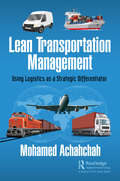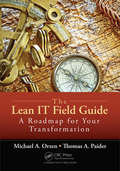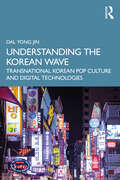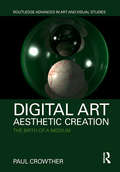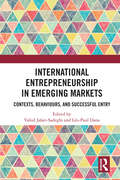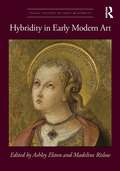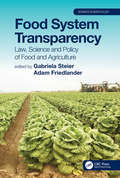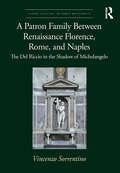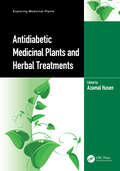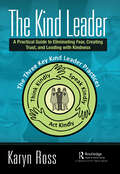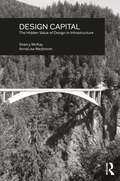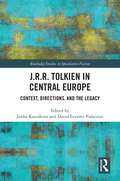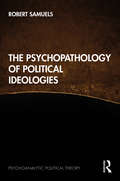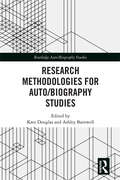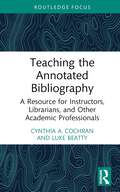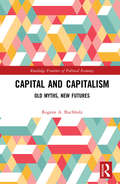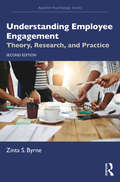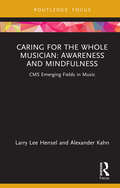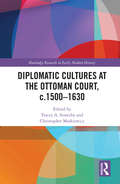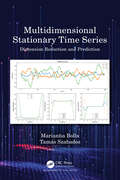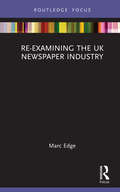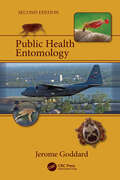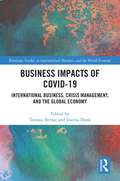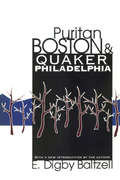- Table View
- List View
Lean Transportation Management: Using Logistics as a Strategic Differentiator
by Mohamed AchahchahThis book provides an overview of the key transportation management processes from a shipper’s perspective. It enables managers to gain quick insight in the added value of transportation as a strategic differentiator, its key drivers, and guidelines on how to use them in an effective and efficient decision-making process. It explains how to identify and eliminate waste using basic Lean tools and proven concepts. The reader is guided on how to start implementing the Lean methodology and best practices in the industry to realize significant savings.Companies such as Adidas and Amazon are using transportation to increase sales by delivering purchased products faster than the competition. These companies do not treat transportation as a cost center. They are not focusing on reducing transportation spending. They allow customers to buy any product that is available in any store or warehouse and have it delivered to their homes. By delivering faster than the competition, they increase sales. At the same time, they lower their total supply chain costs as faster deliveries lead to fewer returns. Reduction of returns means higher sales and lower transportation costs for returns. The result is higher profits while creating more value for the customer.Transportation is moving from a cost center towards a profit center. The traditional logistics service providers are perceived to not innovate fast enough. Top management must understand the transportation management basics and use it in their strategic decision-making. They should be involved in discussions on how to organize the transport management function in the best way and how to use it as a service differentiator. Transportation is more than the efficient movement of supplies, sub-assemblies and final products. In addition, it is more than the key performance indicators on the business-balanced scorecard. Transportation management professionals fail to catch top management’s attention due to the use of technical language. It is more difficult to understand transportation key performance indicators such as loading degree, net and gross pick-up and delivery reliability. It is easier to get top management attention when talking about lost sales due to stock-outs, lost tenders due to long delivery times, high inventory holding and scrap costs.
The Lean IT Field Guide: A Roadmap for Your Transformation
by Michael A. Orzen Thomas A. PaiderHow many IT books have you read that are long on theory and short on practical application? They are interesting, but not very impactful. They provide a framework from which to think and understand, but lack a process from which to act. Addressing this urgent need for the IT community, The Lean IT Field Guide explains how to initiate, execute, and sustain a lean IT transformation.Illuminating a clear path to lean IT, the authors integrate more than two decades of combined experience to provide you with a proven method for creating and sustaining a true lean IT workplace. This field guide not only highlights the organizational techniques of more agile and lean processes, but also the leadership work required to help management adopt these new approaches.Based on proven methods from different industries, including banking, manufacturing, insurance, food and beverage, and logistics, the book details a clear model that covers all the components you need to achieve and sustain a favorable work environment and culture in support of lean IT.Filled with anecdotes and case studies from actual businesses, the book includes pictures, templates, and examples that illustrate the application of the lean methods discussed.
Understanding the Korean Wave: Transnational Korean Pop Culture and Digital Technologies
by Dal Yong JinA comprehensive and critical introduction to understanding the Korean Wave (Hallyu) as a transnational media phenomenon.This book provides an accessible introduction to the Korean Wave—the rapid growth of local cultural industries and the global popularity of Korean popular culture over the past 30 years—providing historical, political, economic, and socio-cultural context to its initial rise and enduring popularity. Jin explores the transnational cultural flows of Hallyu across a variety of products and digital technologies—from television dramas, film, and K-pop to online games, and webtoons—and explains the process of cross-media convergence and the socio-political contexts behind the Hallyu phenomenon. He also explores how overseas fans and audiences advance K-pop fandom as social agents in different geo-cultural contexts. The book concludes by discussing if Hallyu can become a sustainable global popular culture beyond a fan-based regional cultural phenomenon. Each chapter features detailed contemporary case studies and discussion questions to enhance student engagement. This is essential reading for students of Media and Communication, Cultural Studies, Korean Studies, and Asian Studies, particularly those taking classes on popular culture and media, media and globalization, Korean popular culture, and East Asian culture.
Digital Art, Aesthetic Creation: The Birth of a Medium (Routledge Advances in Art and Visual Studies)
by Paul CrowtherIs art created with computers really art? This book answers ‘yes.’ Computers can generate visual art with unique aesthetic effects based on innovations in computer technology and a Postmodern naturalization of technology wherein technology becomes something we live in as well as use. The present study establishes these claims by looking at digital art’s historical emergence from the 1960s to the start of the present century. Paul Crowther, using a philosophical approach to art history, considers the first steps towards digital graphics, their development in terms of three-dimensional abstraction and figuration, and then the complexities of their interactive formats.
International Entrepreneurship in Emerging Markets: Contexts, Behaviours, and Successful Entry (Routledge Studies in International Business and the World Economy)
by Vahid Jafari-Sadeghi Léo-Paul DanaInternational Entrepreneurship in Emerging Markets: Contexts, Behaviours, and Successful Entry aims to provide a comprehensive understanding of international entrepreneurship in emerging markets. This collection of prominent, context-based chapters focuses on entrepreneurial activities in SMEs and analyses a specific dimension of international entrepreneurship in countries belonging to emerging markets. In a constantly evolving international business context, economies can play a crucial role in the promotion and support of firms looking for expanding their market globally. As such, internationalisation, considered as among the most challenging strategies, can provide an opportunity for Small and Medium-Sized Enterprises (SMEs) to seek for performance and growth. In this vein, although international business literature has prominently focused on developed countries, the contribution of emerging markets (EMs) has become as increasingly important contenders on the global scene. Emerging markets are known as growing fast economies, in which they provide an opportunity for SMEs to operate. Therefore, entrepreneurial firms, SMEs in particular, can take advantage of the context unique characteristics of emerging markets to successfully operate and grow not only in domestic but also in international markets. This book is essential reading for researchers, scholars, and practitioners seeking international entrepreneurial activities related to emerging markets.
Hybridity in Early Modern Art (ISSN)
by Ashley Elston Madeline RislowThis collection of essays explores hybridity in early modern art through two primary lenses: hybrid media and hybrid time. The varied approaches in the volume to theories of hybridity reflect the increased presence in art historical scholarship of interdisciplinary frameworks that extend art historical inquiry beyond the single time or material. The essays engage with what happens when an object is considered beyond the point of origin or as a legend of information, the implications of the juxtaposition of disparate media, how the meaning of an object alters over time, and what the conspicuous use of out-of-date styles means for the patron, artist, and/or viewer. Essays examine both canonical and lesser-known works produced by European artists in Italy, northern Europe, and colonial Peru, ca. 1400–1600. The book will be of interest to art historians, visual culture historians, and early modern historians.
Food System Transparency: Law, Science and Policy of Food and Agriculture (Advances in Agroecology)
by Gabriela Steier Adam FriedlanderThis book brings together an international group of agriculture and food lawyers and scientists to define the field of Food System Transparency in three parts: the big picture, food safety and health, and the global view. Each part adds to the whole but zooms in through a unique lens. Investigating social, economic, political, scientific and legal frameworks, this comprehensive volume addresses topics such as food authenticity, agroecological evaluations, and consumer protection. Interwoven themes of transparency contextualize concepts of food safety, information sharing and regulatory opportunities at a local and global scale. Editors’ notes provide blended legal and scientific commentary to facilitate further discussion and context within the classroom. Advantages of this volume include: Chapters written by foremost international experts in their fields Editors’ notes written for classroom use and background information Figures and tables providing illustrations of important concepts Case studies delivering practicality and in-depth analysis to current events A special chapter on COVID-19 and its implications for the food system This book is important reading for graduate-level students, legal scholars, nonlegal academics, advocates for food system transparency and resilience, agroecology and environmental conservation, and practitioners in any cross-disciplinary areas relating to food policy. It will be of interest to all those who seek to deepen their understanding of the concepts and trends surrounding the information that centers around our food system, both domestically in the United States and the European Union, as well as in many major trading nations such as China.Check out the Support Materials tab on www.routledge.com/9780367440367 for a short video previewing some the key themes in the book.
A Patron Family Between Renaissance Florence, Rome, and Naples: The Del Riccio in the Shadow of Michelangelo (ISSN)
by Vincenzo SorrentinoThis book tells the story of the Del Riccio family in Florence in the early modern period, investigating the cultural mediations fostered by the family between Florence, Rome, and Naples, as well as shedding light on the intellectual and social exchanges between different regions of Italy and on the creation of foreign nations within the main Italian cities. These social and cultural dimensions are further explored through the study of the obsessive persistence of the family’s relationship with Michelangelo Buonarroti, exhibited both publicly, in the Florentine and Neapolitan family chapels, and privately in their homes. The main achievement of this study is to move the focus from the ruling power, the Medici family and the immediate members of their court, to a Florentine middle-class family and its social mobility: this shift from the conventional narrative to a distributed microhistory is fundamental to better assess the use of images and artworks in early modern Florence and abroad. The aesthetic and stylistic choices in the use of art and art display made by the Del Riccio reveal a deep awareness of the substantial differences in taste and meaning between different cities of the Italian peninsula. The book will be of interest to scholars working in art history, visual culture, and Renaissance studies.
Antidiabetic Medicinal Plants and Herbal Treatments (Exploring Medicinal Plants)
by Azamal HusenDiabetes is a chronic condition associated with metabolic disorder. Persons suffering from diabetes have shown accelerated levels of blood sugar which often harms the heart, blood vessels, eyes, kidneys, and nerves. Over the past few decades, the prevalence of diabetes has been progressively increasing. Synthetic drugs are used to treat diabetic patients to help control the disorder, but it is shown that numerous medicinal plants and herbal drugs are widely used in several traditional systems of medicine to prevent and treat diabetes. They are reported to produce beneficial effects in combating diabetes and alleviating diabetes-related complications. These plants contain phtyonutrients and phytoconstituents demonstrating protective or disease preventive properties. In many developing countries, herbal drugs are recommended by traditional practitioners for diabetes treatment because the use of synthetic drugs is not affordable.Key Features: Provides botanical descriptions, distribution, and pharmacological investigations of notable medicinal and herbal plants used to prevent or treat diabetes Discusses phytochemical and polyherbal formulations for the management of diabetes and other related complications Contains reports on antidiabetic plants and their potential uses in drug discovery based on their bioactive molecules This volume in the Exploring Medicinal Plants series provides an overview of natural healing treatments in selected antidiabetic plants. The book presents valuable information to scientists, researchers, and students working with medicinal plants or for those specializing in areas of ethnobotany, natural products, pharmacognosy, and other areas of allied healthcare. It is also useful to pharmaceutical companies, industrialists, and health policy makers.
The Kind Leader: A Practical Guide to Eliminating Fear, Creating Trust, and Leading with Kindness
by Karyn RossKindness and leadership aren’t often synonymous. Ask someone to describe "good leadership" to you and you will hear many adjectives used: authentic, bold, challenging, charismatic, decisive, empowering, fearless, goal-oriented, humble, inspiring, original, passionate, role-model, strategic and transparent, to name of a few. And though there are many more that come to mind, kindness isn’t one of them. And here’s the problem with that. Leaders lead. And the way a leader leads – how they do what they do – influences those they lead. From the president of the country, to the president of a company, from middle managers, right down to front-line supervisors, what a leader models – how they think, speak and act – influences the people they lead. Leaders who think, speak and act unkindly give legitimacy and permission to those they lead to think, speak, and act in exactly the same unkind ways. Today, in a world where a leaders’ words and actions travel quickly through social media channels such as Twitter, their influence – unkind or kind – is amplified through repeated views and sharing. In an increasingly fragmented, polarized and divided world, we need leaders who will bring people together not divide them. Leaders who value and model cooperation and collaboration over competition. And who model ways to think kindly, speak kindly and act kindly. We need kindness to become synonymous with good leadership. So that when someone is asked to describe the traits of a good leader, kindness will be the first word that comes to mind. Essentially, the purpose of this book is to teach leaders how to lead with kindness so they can influence the people they lead to create kinder workplaces, organizations and the world. Each chapter contains a mixture of theory, case studies and reflections from leaders and the people they influence. As well, the book follows the fictional stories of Kay’La Janson and Kevin Landrell, as they become leaders in a failing organization that is ultimately turned around through kind leadership. Between chapters there are a series of practical exercises based on concepts presented in the previous chapter with space to record outcomes and reflections on the practice process. This book gives you a deep theoretical understanding of the importance of leading with kindness and also provides practical exercises for you to use to turn theory into practice. Because "change means doing things differently," and because we only really "learn by doing" to create kinder organizations, kinder communities and a kinder world, leaders must be able to begin practicing kindness right away. By the time you finish the book, you will feel confident in your ability to lead with kindness and also to address organizational problems at work, at home and in the community, with kindness.
Design Capital: The Hidden Value of Design in Infrastructure
by Sherry McKay AnnaLisa MeyboomWell-designed infrastructure brings social value that far exceeds its initial construction expenditure, but competition for scarce government funds and a general public perception of infrastructure as mere efficiency, has often left design ill-considered. This book provides designers with the tools needed to argue for the value of design: the ‘design capital’ as the authors term it. In naming and defining design capital, design can once again become part of the discussion and realization of every infrastructure project.Design Capital offers strategies and tools for justifying public spending on design considerations in infrastructure projects. Design has the ability to make infrastructure resonate with cultural or social value, as seen in the case studies, which bestows infrastructure with the potential to accrue design capital. Support for this proposition is drawn from various methodologies of economic valuation and Bourdieu’s theory of cultural capital, explanation of design methodology and education and a series of historical and contemporary case studies. The book also addresses some of the more controversial outcomes associated with contemporary infrastructure: gentrification, globalization and consumer tourism.With this book, designers can make a stronger case for the value of design in public infrastructure.
J.R.R. Tolkien in Central Europe: Context, Directions, and the Legacy (Routledge Studies in Speculative Fiction)
by Janka KascakovaThis volume is a long overdue contribution to the dynamic, but unevenly distributed study of fantasy and J.R.R. Tolkien’s legacy in Central Europe. The chapters move between and across theories of cultural and social history, reception, adaptation, and audience studies, and offer methodological reflections on the various cultural perceptions of Tolkien’s oeuvre and its impact on twenty-first century manifestations. They analyse how discourses about fantasy are produced and mediated, and how processes of re-mediation shape our understanding of the historical coordinates and local peculiarities of fantasy in general, and Tolkien in particular, all that in Central Europe in an age of global fandom. The collection examines the entanglement of fantasy and Central European political and cultural shifts across the past 50 years and traces the ways in which its haunting legacy permeates and subverts different modes and aesthetics across different domains from communist times through today’s media-saturated culture.
The Psychopathology of Political Ideologies (Psychoanalytic Political Theory)
by Robert SamuelsInspired by Freud’s The Psychopathology of Everyday Life, this book examines the unconscious processes shaping contemporary political ideologies.Addressing ten fundamental questions, Robert Samuels identifies four basic political ideologies: liberal, conservative, Left, and Right, which are often placed in the structure of a logical square, determined by two binary oppositions, with a fifth structure of centrism complicating the square. He turns to psychoanalysis to explain the unconscious defense mechanisms that structure these political ideologies. Each chapter uses a recent, influential title as a gateway to the analysis of the ideologies and structures identified. Through this analysis, Samuels argues that belief in ideological structures is tied to triumvirates of institutions and ideals; conservatives being tied to premodern institutions of religion, feudalism, and monarchy, while modern liberals are tied to ideals of universality, objectivity, and empiricism. He concludes that this investment in universality shapes the ethics of modern globalization and democratic liberalism. Unlike other books, conclusions are reinforced through examples drawn from current events with an integrated model of different psychopathologies.The Psychopathology of Political Ideologies moves beyond providing an understanding of what drives different political investments, to offer a more rational and conscious comprehension of subjectivity and social organization. This book will be a great resource for those interested in politics, political science psychology, social psychology, globalization, and ideology.
Research Methodologies for Auto/biography Studies (ISSN)
by Kate Douglas Ashley BarnwellThis collection of short essays provides a rigorous, rich, collaborative space in which scholars and practitioners debate the value of different methodological approaches to the study of life narratives and explore a diverse range of interdisciplinary methods. Auto/biography studies has been one of the most vibrant sub-disciplines to emerge in the humanities and social sciences in the past decade, providing significant links between disciplines including literary studies, languages, linguistics, digital humanities, medical humanities, creative writing, history, gender studies, education, sociology, and anthropology.The essays in this collection position auto/biography as a key discipline for modelling interdisciplinary approaches to methodology and ask: what original and important thinking can auto/biography studies bring to discussions of methodology for literary studies and beyond? And how does the diversity of methodological interventions in auto/biography studies build a strong and diverse research discipline? In including some of auto/biography’s leading international scholars alongside emerging scholars, and exploring key subgenres and practices, this collection showcases knowledge about what we do when engaging in auto/biographical research. Research Methodologies for Auto/biography Studies offers a series of case studies that explore the research practices, reflective behaviours, and ethical considerations that inform auto/biographical research.
Teaching the Annotated Bibliography: A Resource for Instructors, Librarians, and Other Academic Professionals
by Cynthia A. Cochran Luke BeattyThis book informs instructors and librarians about the history, aims, and pedagogical uses of the annotated bibliography. A companion to the authors' Writing the Annotated Bibliography, this text enables instructors to better understand the annotated bibliography not only as a tool for research and composition but also as a valuable pedagogical tool. It provides practical guidance along with assignments, lesson plans, assessment rubrics, and other tools for using annotated bibliographies in effective and nuanced ways. It also contains annotated bibliography samples in APA, MLA, and Chicago styles. This practical book is of great use to instructors of composition and research skills, librarians, curriculum designers, writing center directors, and education professionals.
Capital and Capitalism: Old Myths, New Futures (Routledge Frontiers of Political Economy)
by Rogene A. BuchholzCapitalist societies need to undergo major change to provide for the material needs of all the people who work within the system, not just the 1 percent. They have become dysfunctional and need a different kind of orientation to continue in existence. Instead of creating wealth, which is what they are supposed to accomplish, they have created nothing but debt for the past several decades and are now in serious trouble with regard to finding the wherewithal to keep on functioning as viable societies that can provide job opportunities for their workers and the promise of a better life in the future for their citizens. The coronavirus pandemic has exposed just how many people live paycheck to paycheck and have not been able to accumulate any kind of savings. The 1 percent, meanwhile, have benefited greatly and have vastly increased their wealth over the past several decades. This book does not advocate the need to turn to a form of socialism, however, to give most workers a chance at a decent life for themselves. What is needed is a redefinition of capitalism to make it work for everyone. Capital and Capitalism seeks to uncover various myths about capitalism that hinder our ability to change the system and discuss the task of redefining capitalism by examining where neo-liberalism went wrong and what role restructuring the corporation along stakeholder lines can play in making capitalism more responsive to the entire society.It will be of interest to researchers, academics, and students in the fields of business and society, leadership, and business ethics.
Understanding Employee Engagement: Theory, Research, and Practice (Applied Psychology Series)
by Zinta S. ByrneUnderstanding Employee Engagement is a comprehensive source for the science and practice of employee engagement. This book provides a rigorous and objective review of scholarship and empirical research on engagement from around the world. Grounded in theory and empirical research, this book debates the definitions of engagement, provides a thorough evaluation of empirical findings in the engagement field including a focus on international findings, and offers practice implications for organizations. The book is broad, with references and research across disciplines and countries, as well as new sections addressing current challenges, such as virtual engagement, engaging the aging workforce, and perspectives on diversity and inclusion. Employers can learn how to foster an engaged organization; practitioners can learn how to measure, identify, and implement evidence-based solutions to disengagement; and researchers can master the existing engagement literature and begin to study the many propositions and new models the author proposes throughout the book. This book is an essential read for scholars, researchers, practitioners, and business leaders alike for understanding how to measure, identify, and implement evidence-based solutions to foster employee engagement.
Caring for the Whole Musician: CMS Emerging Fields in Music (CMS Emerging Fields in Music)
by Larry Lee Hensel Alexander KahnCaring for the Whole Musician brings together insights from two expert musicians and educators to consider the relationship between mental and physical health and artistic practice for musicians. Offering a holistic perspective that encompasses the whole being – body, mind, and heart – this book provides emerging musicians with tools, practices, and mindsets to address key challenges throughout their journey.The first part, Awareness, addresses wellness and embodiment in music, exploring how our bodies are constructed and how the use of our bodies as instruments affects function. Using approaches including Body Mapping and the Alexander Technique, this part helps readers discover adverse habits that interfere with natural movement, and nurture awareness of the body. The second part, Mindfulness, explores how meditative practice can be incorporated into every stage of concert preparation and embedded within the daily life of the musician. Offering mindfulness exercises related to each stage of the music-making process, these chapters provide strategies for readers to enhance their well-being and focus.Centered in the understanding of the musician as a whole being, this book provides an essential guide to how practices of awareness and mindfulness can allow musicians to better care for themselves and flourish in their artistic careers.
Diplomatic Cultures at the Ottoman Court, c.1500–1630 (Routledge Research in Early Modern History)
by Tracey A. Sowerby; Christopher MarkiewiczIn the sixteenth century, the Ottoman court in Constantinople emerged as the axial centre of early modern diplomacy in Eurasia. Diplomatic Cultures at the Ottoman Court, c.1500-1630 takes a unique approach to diplomatic relations by focusing on how diplomacy was conducted and diplomatic cultures forged at a single court: the Sublime Porte. It unites studies from the perspectives of European and non-European diplomats with analyses from the perspective of Ottoman officials involved in diplomatic practices. It focuses on a formative period for diplomatic procedure and Ottoman imperial culture by examining the introduction of resident embassies on the one hand, and on the other, changes in Ottoman policy and protocol that resulted from the territorial expansion and cultural transformations of the empire in the sixteenth century. The chapters in this volume approach the practices and processes of diplomacy at the Ottoman court with special attention to ceremonial protocol, diplomatic sociability, gift-giving, cultural exchange, information gathering, and the role of para-diplomatic actors.
Multidimensional Stationary Time Series: Dimension Reduction and Prediction
by Marianna Bolla Tamás SzabadosThis book gives a brief survey of the theory of multidimensional (multivariate), weakly stationary time series, with emphasis on dimension reduction and prediction. Understanding the covered material requires a certain mathematical maturity, a degree of knowledge in probability theory, linear algebra, and also in real, complex and functional analysis. For this, the cited literature and the Appendix contain all necessary material. The main tools of the book include harmonic analysis, some abstract algebra, and state space methods: linear time-invariant filters, factorization of rational spectral densities, and methods that reduce the rank of the spectral density matrix. Serves to find analogies between classical results (Cramer, Wold, Kolmogorov, Wiener, Kálmán, Rozanov) and up-to-date methods for dimension reduction in multidimensional time series Provides a unified treatment for time and frequency domain inferences by using machinery of complex and harmonic analysis, spectral and Smith--McMillan decompositions. Establishes analogies between the time and frequency domain notions and calculations Discusses the Wold's decomposition and the Kolmogorov's classification together, by distinguishing between different types of singularities. Understanding the remote past helps us to characterize the ideal situation where there is a regular part at present. Examples and constructions are also given Establishes a common outline structure for the state space models, prediction, and innovation algorithms with unified notions and principles, which is applicable to real-life high frequency time series It is an ideal companion for graduate students studying the theory of multivariate time series and researchers working in this field.
Re-examining the UK Newspaper Industry (Routledge Focus on Journalism Studies)
by Marc EdgeThis book dispels myths surrounding the newspaper industry’s financial viability in an online world, arguing that widespread predictions of pending newspaper extinction are based mostly on misunderstandings of the industry’s operations.Drawing from his training as a business journalist, Marc Edge undertakes a thorough analysis of annual financial statements provided by newspaper companies themselves to explain the industry’s arcane economics. This book contextualizes available data within the historical context in which various news publishers operate and outlines the economic history of UK newspapers. It also investigates how UK newspapers survived the 2008–09 recession, considering both national and provincial markets separately.A rigorous look at an often-neglected aspect of the newspaper industry, this volume will be an essential read for scholars of media studies, journalism studies, and communication studies, especially those interested in studying journalism and news production as occupational identities.
Public Health Entomology
by Jerome GoddardIn the struggle against vector-borne diseases, it is critical that we bridge the gap among vector control workers on the ground (practitioners), public health planners and administrators, and (academic) medical entomologists. This second edition of Public Health Entomology is designed to fit certificate courses in public health entomology offered by universities and U.S. Centers of Excellence. It comprehensively examines vector-borne disease prevention, surveillance, and control from a governmental and public health perspective with worldwide application.Divided into two sections, the book begins with a historical account of the early beginnings of pest control and public health. Next, it outlines the concepts, design, and implementation of a sound public health entomology program, including issues associated with pesticide use, FEMA and other disaster response entities, and an adverse, chemophobic public. The second section provides an overview of some of the most common public health pests that are found globally. Copious photos and line drawings accentuate the text, along with text boxes and sidebars. The new edition addresses "IPM and Alternative Control Methods" in each section, expands the Lyme disease section, and includes other new and emerging tick-borne diseases (TBD). It provides enhanced discussion of working with local political figures and jurisdictions, as well as partnerships with academia, and is generally more worldwide in scope. Author Jerome Goddard designed and implemented the vector control program along the Mississippi Gulf Coast after Hurricane Katrina. His ability to communicate his knowledge and experience to public health students, professionals, and the general public make this book an essential resource for preventing disease from these vector-borne threats.
Business Impacts of COVID-19: International Business, Crisis Management, and the Global Economy (Routledge Studies in International Business and the World Economy)
by Tomasz BernatThe coronavirus disease (COVID-19) pandemic has caused serious disruptions to the economy and business activities. The COVID-19 crisis has also exposed important weaknesses in business and supply chains. It pointed to specific sectors of the economy, primarily related to services, that suffered the most. On the other hand, it has highlighted the great flexibility of the activities of entrepreneurs in their attempts to fight the crisis.The role of government has also been important in tackling this pandemic crisis to contain the epidemic and adopt activities to help entrepreneurs who were most affected by the crisis. Numerous national aid and recovery packages have been announced to support businesses and workers. At the same time, financial decisions were made at the international level, resulting in the mobilization of huge funds that were intended to support the functioning of enterprises.This book shares observations and conclusions from contemporary research and analyses, as well as from personal experiences in creating and implementing anti-crisis solutions in economies and enterprises caused by the COVID-19 pandemic on the economy and its entities. It will be of interest to researchers, academics, policymakers, and students in the fields of international business, economics, crisis management, and entrepreneurship.
Puritan Boston and Quaker Philadelphia
by E. Digby BaltzellBased on the biographies of some three hundred people in each city, this book shows how such distinguished Boston families as the Adamses, Cabots, Lowells, and Peabodys have produced many generations of men and women who have made major contributions to the intellectual, educational, and political life of their state and nation. At the same time, comparable Philadelphia families such as the Biddles, Cadwaladers, Ingersolls, and Drexels have contributed far fewer leaders to their state and nation. From the days of Benjamin Franklin and Stephen Girard down to the present, what leadership there has been in Philadelphia has largely been provided by self-made men, often, like Franklin, born outside Pennsylvania.Baltzell traces the differences in class authority and leadership in these two cites to the contrasting values of the Puritan founders of the Bay Colony and the Quaker founders of the City of Brotherly Love. While Puritans placed great value on the calling or devotion to one's chosen vocation, Quakers have always placed more emphasis on being a good person than on being a good judge or statesman. Puritan Boston and Quaker Philadelphia presents a provocative view of two contrasting upper classes and also reflects the author's larger concern with the conflicting values of hierarchy and egalitarianism in American history.
Air Pollution Control Equipment Selection Guide
by Kenneth C. SchifftnerThis new edition of Air Pollution Control Equipment Selection Guide builds upon the successes of previous editions that developed a detailed discussion on various technologies used for air pollution control. This book covers a wide range of equipment and provides a good overview of the related principles and applications. A particularly valuable feature are the practical examples, not commonly available in other books. Based on the author’s fifty years of experience in applying and operating air pollution control equipment, this book provides easy-to-read information on basic air pollution control technology and is the quintessential resource for the busy engineer and for those who do not have formal training in air pollution control.FEATURES OF THE THIRD EDITION Uniform and consistent applications information for comparing the effectiveness of different technologies. Provides answers to questions about how to reduce operating costs and how to achieve peak performance. Concise descriptions of each equipment with diagnostics and testing suggestions. New chapters on optimization techniques that help readers deal with different types of hardware for better performance and efficacy.
